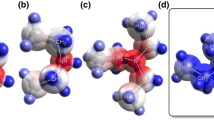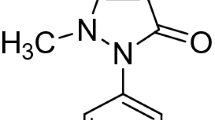Abstract
We present the crystal structures of the chloride salts of the mono-guanidinium 1 (–CH2CH2– linker) and the bis-isouronium 2 (–O– linker) that have been resolved by us indicating that these compounds are diprotonated in the solid state as informed by the counterions positions. To determine the pK a values of these compounds as well as those of their analogues 3 (mono-2-aminoimidazolinium with a –CH2CH2– linker) and 4 (mono-guanidinium with a –O– linker), the corresponding UV–Vis titrations were carried out. Thus, in aqueous solution compounds 1, 3 and 4 were present as mono-cationic species while derivative 2 was a bis-cation.







Similar content being viewed by others
Notes
CCDC-contains the supplementary crystallographic data for this paper. CCDC depository numbers for compounds 1 and 2 are CCDC 733785 and CCDC 733784, respectively. These data can be obtained free of charge at www.ccdc.cam.ac.uk/conts/retrieving.html [or from the Cambridge Crystallographic Data Centre (CCDC), 12 Union Road, Cambridge CB2 1EZ, UK; fax: +44(0)1223-336033; email: deposit@ccdc.cam.ac.uk].
References
Rodriguez F, Rozas I, Kaiser M, Brun R, Nguyen B, Wilson WD, Garcia RN, Dardonville C (2008) New bis(2–aminoimidazoline) and bis-guanidne DNA minor groove binders with potent in vivo antitrypanosomal and antiplasmodial activity. J Med Chem 51:909–923
Nagle PS, Rodriguez F, Kahvedžić A, Quinn SJ, Rozas I (2009) Non-symmetrical diaromatic guanidinium/2-aminoimidazolinium derivatives: synthesis and DNA affinity. J Med Chem 52:7113–7121
Nagle PS, Rodriguez F, Quinn SJ, O’Donovan DH, Kelly JM, Nguyen B, Wilson WD, Rozas I (2010) Biophysical studies on the DNA interaction with non-symmetrical guanidinium/2-aminoimidazolinium derivatives. Org Biomol Chem 8:5558–5567
Rodriguez F, Rozas I, Ortega JE, Meana JJ, Callado LF (2007) Guanidine and 2-aminoimidazoline aromatic derivatives as α2-adrenoceptor antagonists, 1: towards new antidepressants with heteroatomic linkers. J Med Chem 50:4516–4527
Rodriguez F, Rozas I, Ortega JE, Erdozain AM, Meana JJ, Callado LF (2008) Guanidine and 2-aminoimidazoline aromatic derivatives as α2-adrenoceptor antagonists, 2: exploring aliphatic linkers. J Med Chem 51:3304–3312
Rodriguez F, Rozas I, Ortega JE, Erdozain AM, Meana JJ, Callado LF (2009) Guanidine and 2-aminoimidazoline aromatic derivatives as α2-adrenoceptor ligands: searching for structure-activity relationships. J Med Chem 52:601–609
Kinsella GK, Watson GW, Rozas I (2006) Theoretical proton affinities of α1 adrenoceptor ligands. Bioorg Med Chem 14:1580–1587
Kinsella GK, Rodriguez F, Watson GW, Rozas I (2007) Computational approach to the basicity of a series of α1 adrenoceptor ligands in aqueous solution. Bioorg Med Chem 15:2850–2855
Goonan A, Kahvedžić A, Rodriguez F, Nagle P, McCabe T, Rozas I, Erdozain AM, Meana JJ, Callado LF (2008) Novel synthesis and pharmacological evaluation as α2-adrenoceptor ligands of O-phenylisouronium salts. Bioorg Med Chem 16:8210–8217
Dardonville C, Goya P, Rozas I, Alsasua A, Martin I, Borrego MJ (2000) New aromatic iminoimidazolidine derivatives as alpha1-adrenoceptor antagonists: a novel synthetic approach and pharmacological activity. Bioorg Med Chem 8:1567–1577
Software Reference Manual, version 5.625; Bruker Analytical X-Ray Systems Inc.: Madison, WI, 2001. Sheldrick, G. M. SHELXTL, An Integrated System for Data Collection, Processing, Structure Solution and Refinement; Bruker Analytical X-Ray Systems Inc.: Madison, WI, 2001
Macrae CF, Bruno IJ, Chisholm JA, Edgington PR, McCabe P, Pidcock E, Rodriguez-Monge L, Taylor R, van de Streek J, Wood PA (2008) Mercury CSD 2.4-new features for the visualization and investigation of crystal structures. J Appl Cryst 41:466–470
Brown CJ (1949) The crystal structure of aniline hydrochloride. Acta Crystallogr 2:228–232
Cambridge Structural Database (CSD) search
Haas DJ, Harris DR, Mills HH (1965) The crystal structure of guanidinium chloride. Acta Crystallogr 19:676–679
Palm VA (ed) (1975–1979) Tables of rate and equilibrium constants of heterolytic organic reactions, VINITI, volume II-1. Guanidines. Tartu University Publishing House, Jakobi, pp 326–328
Acknowledgements
This research was funded by the SFI-RFP project CHE275.
Author information
Authors and Affiliations
Corresponding author
Rights and permissions
About this article
Cite this article
Nagle, P.S., Kahvedžić, A., McCabe, T. et al. On the protonated state of amidinium-like diaromatic derivatives: X-ray and UV studies. Struct Chem 23, 315–323 (2012). https://doi.org/10.1007/s11224-011-9861-5
Received:
Accepted:
Published:
Issue Date:
DOI: https://doi.org/10.1007/s11224-011-9861-5




